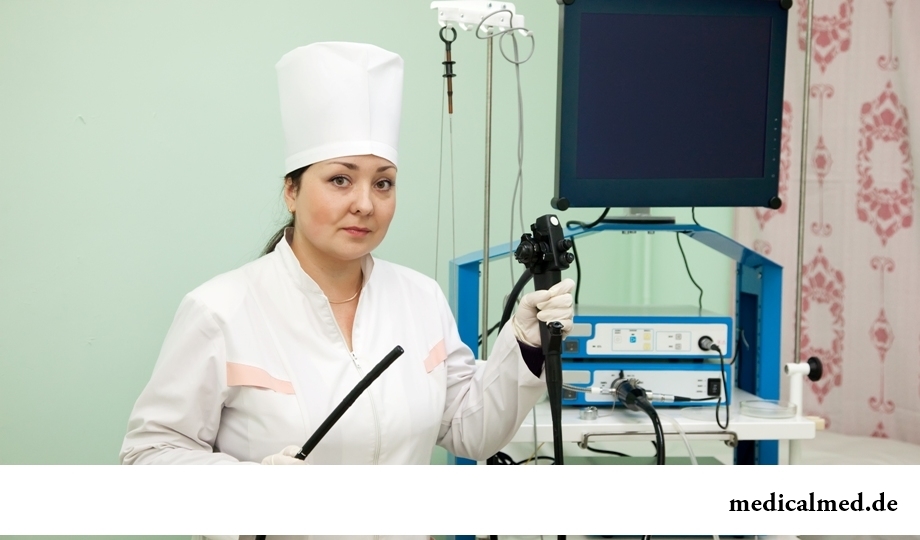





Endoscopist
The endoscopist – the doctor conducting a tool research by means of lighting and optical system. This procedure allows to examine internal tubular or band bodies, without resorting to operation.

Endoscopy as the direction of medicine, received the name from the Greek words "endon" – inside and "skopeo" – to watch, investigate.
Endoscopy found the broad application for the diagnostic purposes and at treatment of many diseases in gastroenterology, surgery, otorhinolaryngology, pulmonology and other fields of medicine.
The instrument of endoscopy is the endoscope representing the flexible long tube which is coming to the end with a lens. The image received from the endoscope with a condition of an internal surface of body is transferred to the special screen from which the endoscopist can take the picture.
In what purposes endoscopy is applied
Work of the endoscopist allows to carry out early diagnosis and treatment of many serious diseases, such as tuberculosis, a carcinoma of the stomach and lungs, various forms of female infertility.
Work of the endoscopist is necessary for carrying out:
- Diagnoses. The endoscope allows to see color of mucous membranes, erosion, ulcers, hems, new growths and to note its differences from norm. The endoscopist reports the obtained data to the attending physician for diagnosis. Also by means of the endoscope it is possible to find a bleeding point, without resorting to an operative measure;
- Treatments. The endoscope can be used for administration of medicines directly to the struck area. An opportunity to enter surgical instruments by means of the endoscope allows the endoscopist to carry out medical manipulations, such as removal of small polyps or laser therapy;
- Control of the treatment course. Thanks to the fact that endoscopy allows to take the picture of pathological sites the repeated research helps the endoscopist to track dynamics of development of a disease and to record the positive and negative changes happening during treatment;
- Biopsies. In need of histologic and histochemical researches the endoscopist can carry out a material intake from the surfaces of mucous membranes of the damaged bodies for the subsequent transfer to laboratories for the analysis.
Carrying out researches by the endoscopist
Endoscopic procedures are usually well postponed by patients owing to the fact that the mucous membrane on which medical manipulations are carried out is deprived of nerve terminations.
Nevertheless, diagnostic and operational endoscopic testings are recommended to be conducted under anesthetic. Such practice is accepted in many developed countries that allows to carry out the procedure most comfortably for the endoscopist and the patient: the doctor can execute a necessary complex of diagnosis or treatment precisely and quickly, and the patient at the same time does not feel discomfort.
Work of the endoscopist is necessary at a wide range of diseases among which:
- Gastrojejunal ulcer;
- Stomach ulcer and 12-perstny gut;
- Duodenitis;
- Chronic ulcer and cicatricial deformation of a bulb of DPK;
- Gullet varicosity, gullet diverticulums, Mellori-Weiss's syndrome;
- Papillitis;
- Benign tumors and cancer of a gullet;
- Cancer and polypectomy of a large intestine.
Main types of the researches conducted by the endoscopist
Depending on the studied bodies in work of the endoscopist distinguish:
- Bronkhoskopiya – survey of bronchial tubes;
- Rektoromanoskopiya – survey of distal department of a sigmoid gut and a rectum;
- Ventrikuloskopiya – a research of cerebral cavities;
- Gastroscopy – survey of a stomach;
- Arthroscopy – a research of joints;
- Hysteroscopy – endoscopy of a cavity of the uterus;
- Angioskopiya – a research of vessels;
- Kardioskopiya – survey of cavities of cameras of heart;
- Kolonoskopiya – endoscopy of a large intestine (mucous membrane);
- Torakoskopiya – a research of a chest cavity;
- Fistuloskopiya – a research of internal and outside fistulas;
- Kolposkopiya – survey of vulval walls and an entrance to a vagina;
- Ezofagogastroduodenoskopiya – survey and treatment of a gastric cavity, a gullet and a 12-perstny gut;
- Tsistoskopiya – a bladder research;
- Laparoscopy – endoscopy of an abdominal cavity;
- Holangioskopiya – survey and treatment of bilious channels;
- Ureteroskopiya – survey of an ureter;
- Otoskopiya – endoscopy of a tympanic membrane and outside acoustical pass.
How to receive the endoscopist's profession
To work by profession the endoscopist, it is necessary to have the higher medical education which corresponds to specialization. In addition to medical knowledge the endoscopist has to be able to work with the computer and the necessary equipment.
The first vibrator was invented in the 19th century. It worked at the steam engine and intended for treatment of female hysteria.

All know that self-treatment is dangerous. However absolutely it is almost impossible to do without it. Rate of modern life not on...
Section: Articles about health
Dark circles (bruises) under eyes – a shortcoming with most of which often fight against the help of cosmetics (proofreaders, saloon procedures and so forth), eliminating only its visibility. However, according to doctors, skin around eyes – the indicator of many disturbances in an organism...
Section: Articles about health
The state of health of the person in many respects depends on chemical composition of biological liquids of an organism. Specialists consider that PH value of these solutions has to be in range of 7,35-7, 45. The deviation in the smaller party (so-called "acidulation") is fraught with development of many heavy illnesses, failures in work of immune system, decrease in working capacity and deterioration of life. To avoid serious fluctuations of acidity of internal liquids it is necessary to adhere разумног...
Section: Articles about health
Water with a lemon - idle time in preparation drink which supporters of a healthy lifestyle already managed to appreciate. Upo...
Section: Articles about health
Heart disease and blood vessels lead to disturbance of blood supply of bodies and fabrics that involves failures in their work, deterioration in health of the person, decrease in its working capacity and standard of living. Annually such perishes from pathologies more...
Section: Articles about health
Each of us faces from time to time that other people need the immediate help. We react to it differently: one at once call doctors and police, others rush to victims and try to save them independently. Some pass by at all … Certainly, desire to help the neighbor who got into trouble, quite naturally for any decent person. However not everyone understands that to work in a similar situation, being guided by exclusively good...
Section: Articles about health
We live during an advertizing era. Daily each person receives a solid portion of persuasive councils about what to eat to be здо...
Section: Articles about health
Cold is such painful that each sigh becomes a victory, heat "knocks" down, and the ache in joints forces to think only of pain. Some people with approach of the first symptoms of cold make the self-sacrificing decision to have a disease standing, and to a beam...
Section: Articles about health
Modern footwear is extremely various. It stopped being only protection for legs long ago. Today shoes, boots, barefoot persons choose not so much proceeding from their convenience and functionality how many being guided by outward, brand and an opportunity to add with them a stylish dress. At the same time, buying footwear, think of its safety a little. Meanwhile, many popular models can do essential harm to health....
Section: Articles about health
The chia plant, or the Spanish sage, is from South America. The indigenous people of the continent since ancient times used in food it семена:...
Section: Articles about health
With age in a human body harmful substances collect. We receive them with food and water, at inhalation of the contaminated air, reception of medicines, use of household chemicals and cosmetics. A considerable part of toxins accumulates in a liver, osnovno...
Section: Articles about health
Sometimes it seems that modern society was divided into two camps: representatives of the first are sure that only the woman has to be responsible for contraception, representatives of the second, respectively, are sure that it is destiny of men. Meanwhile the question of contraception has very many aspects – both psychological, and legal and, of course, medical....
Section: Articles about health
All parents are ready to what the baby often and pisat much. Since then, as the absorbing diapers strongly became current...
Section: Articles about health
Stability of a hormonal background is one of the most important conditions of preservation of health of the woman. At the same time endocrine system – the thin device extremely sensitive to any external influences. Changes of an image жиз can become the reason of hormonal failure...
Section: Articles about health
Run - one of the most available and effective ways to revitalize the organism. Knowing about its extraordinary advantage, each of us at least once tried to make jogs, but only the few made these occupations regular. In spite of the fact that in jogging (easy jogging), apparently, there is nothing difficult, the beginning runners often make mistakes which lead to complete cessation of trainings. Let's consider 10 useful tips for beginners who will allow them to make regular п...
Section: Articles about health
There comes the season of issues. Many Russians already dream of outdoor recreation, trips, beautiful seaside beaches....
Section: Articles about health
Life of the modern child is extremely active and difficult. Information strain which is experienced by the school student and did not dream pupils of last times. Careful parents, wishing well to the children, will organize a set of additional classes in circles, sports...
Section: Articles about health
Each failure in work of bodies and systems of a human body is, as a rule, shown by the whole complex of symptoms. In particular, malfunctions with health often cause emergence of cosmetic defects in the form of rashes on a face. Experienced doctors know that localization of heat-spots usually depends on what disease the patient has....
Section: Articles about health
The mankind knows that some toxins at intake in the minimum quantities have therapeutic effect...
Section: Articles about health
When overcomes feeling of hunger, and an opportunity to have dinner fully is absent, having a snack − the meals, small on volume, stabilizing sugar level in blood comes to the rescue. The relation of nutritionists to having a snack is more often negative, but only because in кач...
Section: Articles about health
Bulimia and anorexia, are heavy deviations of a feeding behavior, become a cause of death of patients much more often than all other nervous breakdowns combined. In 60% of cases two illnesses accompany each other: patients feel horror before danger of set of excess weight and try to refuse as often as possible food, but periodically suffer from attacks of sudden hunger and an uncontrollable overeating. Each patient with anorexia and bulimia needs the help qualified пс...
Section: Articles about health
The Genetically Modified Organisms (GMO) are plants or animals (as a rule, agricultural) in whose genotype...
Section: Articles about health
According to data of World Health Organization, the cataract is diagnosed almost for 7% of the population of Earth. The statistics of incidence is considered not full as at an initial stage the illness, as a rule, does not cause to the person of special inconveniences, and many having got sick...
Section: Articles about health
Antibiotics - - it is possible to call the chemical compounds suppressing growth of bacteria the break in the field of medicine which allowed to save mankind from many diseases incurable earlier: tuberculosis, plague, syphilis and many others. The contribution of drugs to rescue of people from epidemics of dangerous infections is huge, however at careless use antibiotics are capable to cause to an organism serious damage. Negative action can be shown in the form of easing of immunity, disturbance of balance of microflora in кишеч...
Section: Articles about health
Work of a brain is extremely complex and in many respects is not studied yet. It is confirmed also by the features of thought processes which are shown in...
Section: Articles about health
Not without reason doctors say that 90% of diseases begin or develop because of misoperation of intestines. Disturbance of its functions is connected with various factors among which the important place belongs to excessive "clutter" of an intestinal path. In an organism скаплив...
Section: Articles about health
Feeding by a breast - the integral part of ideal motherhood allowing to come into contact with the kid and to create to it healthy immunity since early years. Nevertheless, this important process in life of mother and child can be saddened laktostazy − by a milk delay in a mammary gland. What main reasons for a laktostaz? How not to allow problems with breastfeeding? Let's consider 10 premises resulting in stagnation of milk at the nursing mother....
Section: Articles about health
